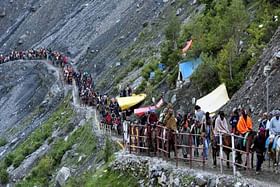The tracks leading to the Amarnath shrine have been revamped by the Border Roads Organisation (BRO) recently, improving accessibility for pilgrims who travel by foot, palkis and ponies.
Under Project Beacon, the Border Roads Organisation (BRO) expanded the road to the Amarnath cave shrine, and they have shared a video highlighting the successful journey of the first vehicles reaching the destination.
Amarnath cave shrine in Jammu and Kashmir (J&K) is nestled in the snow-clad Himalayas within Kashmir’s Lidder Valley.
Every year, millions of devotees embark on the challenging pilgrimage through rugged terrain to reach the Amarnath shrine. The trek to Amarnath, undertaken during the month of Shravan (July-August), draws a devout crowd to this remarkable shrine.
Amarnath cave shrine in south Kashmir is considered to be one of the major Hindu Dhams and the abode of Lord Shiva.
Pilgrims can access the shrine via two routes, either through Pahalgam or Sonamarg, both located in the picturesque Lidder Valley.
The cave is positioned 48 km north of Pahalgam. The first leg of the journey covers a motorable distance of 16 km from Pahalgam to Chandanwari.
From Chandanwari onward, pilgrims face challenging terrain, and they undertake the remaining journey either on foot or by pony. Navigating through this demanding landscape, the pilgrimage to the shrine typically takes three to five days via this route.
From Sonamarg, the route through Baltal offers a significantly shorter journey to the Amarnath shrine. Covering a distance of 14 km between Baltal and the shrine, pilgrims typically complete this stretch in eight hours on foot or less than six hours on a pony.
While most pilgrims choose to stay overnight at Amarnath, it is also feasible to complete a round trip in a single day.
Additionally, pilgrims have the option to reach the shrine via helicopters, which operate from Baltal to Panchtarni, situated 6 km away from the shrine.
The services that once transported pilgrims directly to the shrine were discontinued due to ecological concerns, attributing the rapid melting of the lingam to the use of helicopters.
In April of this year, Union Minister Gadkari unveiled a plan aimed at significantly improving access to the Amarnath shrine. This ambitious plan, allocated a budget of Rs 5,300 crore, involves the development of a 34 km two-lane motorable road from Chandanwari (on the Pahalgam side) to Baltal (on the Sonamarg side).
It includes the construction of a 10.8 km tunnel from Sheshnag to Panchtarni, the most challenging segment of the trek on the Pahalgam route, passing through Mahagunus Top at an altitude of 14,500 feet. A 5 km concrete pedestrian track is planned to connect pilgrims from Panchtarni to the shrine.
Alternatively, pilgrims will have the option to take a 9 km ropeway from Baltal to the shrine, with an estimated cost of Rs 750 crore.
The maintenance and improvement of pedestrian tracks from both Baltal and Chandanwari to the shrine were transferred from the J&K government’s Roads & Buildings (R&B) department to the BRO in September 2022.
BRO officials reported that the existing tracks on the Baltal route have been widened to up to 15 feet, sufficient for trucks and pick-up vehicles to reach the cave shrine.
However, as of now, tourist vehicles are not permitted on the route, with the widening primarily aimed at alleviating congestion for trekking pilgrims.


